Tech News
The Xbox headset "king of convenience" returns with multi-faceted support for mobile, Xbox One / Series X|S, PlayStation, and PC — wrapped in one glorious package
Quick Menu
I'm an avowed Astro A50 fan, having used every iteration of the headset since its inception. I was excited to finally try out the Astro A50 (Gen 5) for this review. The headset was launched in September 2024. As I built this review, I had one big personal question I needed the Astro A50 (Gen 5) to answer.
I use the Astro A50 (Gen 4) model from 2019 as my primary headset. I built my setup around the headset, too, owing to its SPDIF optical-in, which has become a rarity among the best Xbox headsets and best PC gaming headsets alike. But despite my headset's age and despite having dozens upon dozens of other options from the mountain of reviews I've done over the years, I've yet to upgrade. But why?
I've stuck with the Astro A50 Gen 4 for so long because of the dual audio mixing SPDIF offers. You can merge sound from your TV directly (and, by proxy, your Xbox) while setting the headset into PC USB mode for Discord and live streaming on platforms like YouTube and Twitch. But perhaps with the Astro A50 (Gen 5) available now for $299 at retailers like Amazon and Best Buy, can I finally, finally let my aging 5-year-old headset find its rest?
Not to be confused with the Astro A50 X, which has HDMI audio pass-through, the Astro A50 (Gen 5) is a more standard version of that headset, which ditches the pricy triple-HDMI setup for something more traditional. Instead, you get 3 USB-C ports: one for PC, one for Nintendo Switch and PS5, and one for Xbox One and Series X|S consoles. With a handy button on the headset, you can seamlessly switch between them on the fly. You also have dual sound source mixing powered by Bluetooth as well for good measure.
This is by no means the first headset that has included these types of features, but how does it stack up in practice? The answer is very, very well, actually. Here's our full review of the Astro A50 (Gen 5), tested by me — someone who has very, VERY heavily used every previous version.

I've been reviewing gaming headsets for ten years at this point, starting out as an independent blogger and working my way up to exec editor over here at Windows Central. In particular, with regards to the Astro A50, I've used every single iteration of this headset and currently call the Astro A50 (Gen 4) my primary headset for the past few years. I dare say there's nobody better placed to review the Astro A50 (Gen 5) than me.
This headset was reviewed with an Astro A50 (Gen 5) unit provided by Logitech G. Logitech did not see the contents of this review prior to posting.
Astro A50 (Gen 5, 2024): Specs & Price

Astro A50 Spec Sheet
USB
audio:
24
bit
on
PC,
16
bit
on
Xbox
and
consoles
Weight:
363
grams
Drivers:
40
mm
"Pro-G"
Graphene
Freq.
response:
20Hz
to
20
kHz
Features:
Dolby
Atmos
and
Windows
Sonic
Compatible,
Bluetooth
dual-device
sound
mixing,
recharging
base
station
with
multi-platform
USB-C
support
Compatibility:
Xbox,
PC,
PlayStation,
Nintendo
Switch,
Bluetooth
devices
Battery
life:
~24
hours
Price:
$299
At first glance, the Astro A50 (Gen 5) looks remarkably similar to its predecessor, both visually and from the spec sheet. However, there are some nuances worth pointing out. We're still at 20 Hz to 20 kHz (which tends to be the standard audio range for most headsets, with 40mm drivers (albeit graphene this time). However, this time around, we lose the SPDIF optical audio sockets, typically used to connect the base station to a TV or sound system and grab three USB-C ports instead.
The three ports connect up PC, PlayStation / Nintendo Switch, or an Xbox One / Series X|S system simultaneously (although the necessary cables for all three platforms are not included, sadly). We also now have Bluetooth support with dual-source mixing for true multi-modal freedom.
The footprint of the headset is largely the same, using the same plastic shells the company has been using for a while now (and if you have a previous generation's leatherette mod kit, it'll work on the Gen 5, too). However, the base station now has a Logitech logo to reflect the fact it acquired Astro a short while ago.
The headset is still $299 in the United States and is now available to buy at most retailers, notably Amazon and Logitech G itself.
Astro A50 (Gen 5, 2024): Build Quality and Comfort
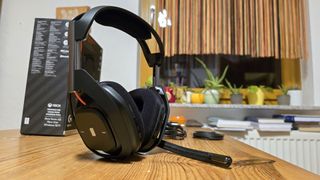
Astro has always been relatively exemplary when it comes to building quality, hard-wearing products, and this headset is absolutely no exception. Sporting the same overall design as its predecessor, I know from how badly I've battered the Astro A50 (Gen 4) over the past five years that this is a hard-wearing, hard-working headset that will stand up to the test of time. After five years, some of the paint has worn down on certain parts, but I don't think I've ever abused a headset more than the A50 (Gen 4), which fills me with confidence that the Astro A50 (Gen 5) will offer users the same longevity.
The headset sports runners on either side for easy adjustments, connected with unique clasps on top of an aluminum tube. It's not exactly what I'd call fashionable, but given that it has no detachable microphone, it's unlikely you'll want to use this headset on your daily commute anyway, even if it does have Bluetooth. Design-wise, it looks nice enough, and now it sports red accents instead of the bronze-ish color of its predecessor, which I think looks a bit nicer, at least personally. Design critique is subjective, though.
What I would say is less subjective is how comfortable it is. I'm grateful to report that the Astro A50 (Gen 5) delivers there too. It sports exactly the same design as its predecessor for the most part, which I find to be among the more comfortable headsets I've used as someone with a disproportionately large head and thick hair to boot (I don't think I've ever found a hat that actually fits comfortably). The wide degree of customization should ensure that it fits you pretty well, too, regardless of your cranial requirements.

One aspect of the Astro A50 that I've generally not been a fan of is the fabric earcups. They're not exactly uncomfortable, but I feel like they get warm on the skin over time, and the headband, in particular, is perhaps not as cushioned as it could be. Astro apparently agrees, given that it sells a $50 leatherette A50 mod kit on its website. I picked this up twice because it genuinely makes a big difference to the feel of the headset. In a perfect world, I feel like the leather cushions should come as standard, but it was undoubtedly done to keep costs down on Astro's end. And to be fair, there is a ton on offer here.
The Astro A50 (Gen 5) itself lasts up to 24 hours on a single charge, and the base station is better than ever. On the previous generation's base station, I often found it a bit hard to seat the headset in and sometimes awkward to get the connectors to attach for charging. Astro has improved the base station's ergonomics here, making it much easier to drop and go. It sports a collection of LED lights to let you know the charge status and remind you what mode the headset is in. I usually hate LEDs on devices like this since my "office" is also my bedroom, and having a Christmas disco of LEDs blinking around my bedroom is often annoying. It's made all the more annoying since the base station now requires a dedicated power supply (included in the box), meaning the lights will be on 24/7 if you don't disconnect the power. Thankfully, you can turn the lights off using the Logitech G software app, which, by the way, is pretty good.
Overall, it's a bit of a downer that the headset requires a dedicated power supply now, which might be difficult depending on your setup, but it does have a ton of additional features compared to its predecessor. There aren't really any other headsets on the market that can boast the Astro A50's raw versatility, and that crown looks set to remain with the Gen 5.
Using the Logitech G Hub app, you can easily customize the side tone and noise gate on the mic while setting up EQ profiles for different scenarios. There's also a Bluetooth mobile app that offers similar (albeit more limited) functionality if you don't have access to a PC, but I've found both ultimately cover the basics. It would be nice for both of these apps to get more configuration features, but it still seems relatively fresh for Logitech, at least compared to the old Astro Command Center app, so we'll likely see improvements there over time.
Speaking of Bluetooth, the headset's new headline feature is the ability to be compatible with practically everything. I'll talk a little more about signal strength in the audio section, but what this ultimately represents is Astro doubling down on what makes this headset so unique. The versatility and convenience of the Astro A50 is a big draw, and the ability to switch between PlayStation, PC, and Xbox USB connections with a single headset button is an absolute joy. If you have spare cables, that is. Indeed, the Astro A50 (Gen 5) only comes with enough USB-C cables to support one connected device. I'm sure many of you reading this probably (like me) have a drawer full of black wires "you might need" someday. Well, hey, this might just be that drawer's time to shine.
You can also feed in a second sound source with Bluetooth into the audio mix, which is a really great feature for streamers who want to collect audio from a console while also using a PC for audio configuration or comms.
Astro A50 (Gen 5, 2024): Audio and Features
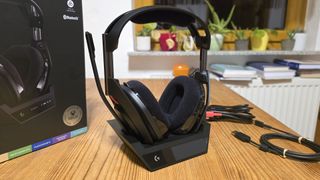
The Astro A50 line has never exactly been "mind-blowing" when it comes to sound reproduction, and I think that's part of the compromises Astro has to hit in order to make them so effortlessly versatile. After all, there are many headsets in this price bracket that don't even come close to the Astro A50's feature set while also maintaining the same price point, so it's perhaps to be expected that there are some (very mild) sacrifices to be made somewhere.
That's not to say the Astro A50 (Gen 5) has poor audio, though. Far from it, actually, but if you're particularly passionate about immersive, cinematic sound above all else, there are probably better options worth considering. The Astro A50 (Gen 5) does absolutely deliver, though, overall. It just doesn't get top marks.
The Astro A50 (Gen 5) comes with a potent software solution known as the Logitech G Hub that lets you tune the EQ profile to your preference, but I struggled to get the soundscape to a place where I found it to be truly impressive. It is very serviceable, though, with great, powerful bass when you need it and decent highs and bass highs for situational awareness. Playing Valorant (where hearing footsteps is absolutely crucial) was more than serviceable on this headset, and I never felt like I was disadvantaged by the gear.
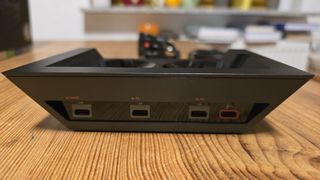
The Logitech G offers a balanced wave profile, as well as profiles designed for media and gaming. The media preset is also perhaps best used in single-player cinematic experiences if you don't fancy customizing your setup further.
For tactical play, the headset does the job, but I did find it a bit lacking when it came to raw cinematic immersion, particularly when it came to music and overall soundstage separation. The bass is impressive in these situations, as I mentioned, and an improvement, I'd say, from previous Astro headsets, but the treble and mids treatment can sometimes impede detail in certain corners. Guitars in rock music, for example, don't sound as impressive as they perhaps could, and the narrow sound stage can take the edge off cinematics that would perhaps be better served with a different sound setup. But I can't emphasize how much I'm nitpicking here, honestly. Unless you're very particular about your sound experience, the Astro A50 (Gen 5) more than delivers, as its predecessors do. And sound critique is often quite subjective I find, you might find them to be perfect, particularly if you're a fan of beefy, detailed bass.
One area of the sound experience that is exceptionally impressive is the signal isolation between Bluetooth and the standard 2.4 GHz RF frequencies used by the base station. One pitfall I often struggle with in headsets that try to do dual-source mixing between Bluetooth and their onboard wireless is corruption between the two. I find myself using dual sound sources often as a streamer, feeding comms through my PC while grabbing audio from my Xbox either via SPDIF or Bluetooth, which is one reason I've stuck with the Astro A50 (Gen 4) for so long. Most headsets that incorporate Bluetooth over SPDIF to achieve dual source mixing seem to do a poor job of shielding the signal from interference. Not here, though. I played on Xbox for several hours with the Astro A50 (Gen 5), which was connected directly to my TV with Bluetooth while connected via USB to my PC for Discord. Therein, I didn't experience a single pixel of performance degradation. Top marks there.
Another surprisingly great aspect of this headset is the microphone experience. The Logitech G hub settings let you fine-tune the side-tone mic monitoring and noise gate experience to your liking (although I'm not sure why the feature was under settings rather than microphone there), and it comes with the flip-to-mute feature as standard.
It does all the standard stuff well, but as you can hear in the sample above (you may need to turn off ad blockers if you can't see it), it sounds rather amazing for a "gaming headset." I find that the microphone experience is often left at the gate as an easy area of compromise for a lot of manufacturers, but the Astro A50 (Gen 5) is undoubtedly among the best I've used. I think it might be good enough to be viable for content creation, too, which is not something I'd often suggest. More top marks there for the Astro A50 (Gen 5).
Overall, the Astro A50 (Gen 5) delivers a solid sound experience that perhaps won't win awards by itself but ultimately gets the job well and truly done. Your tactical play in games like Valorant or Call of Duty won't be compromised, and while I think there might be better options for cinematic games or music, it's still a great experience you'll ultimately find satisfying.
Astro A50 (Gen 5, 2024): Competition
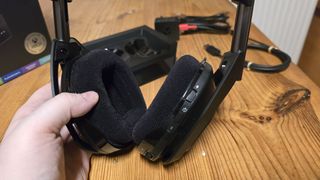
The Astro A50 (Gen 5) is arguably in a league of its own, given its battery charge dock. There are no other real competitors in this space offering something similar, at least not without heavy compromises on other aspects of the overall product.
At least in this price range, the only other option worth considering for multi-platform gaming is the SteelSeries Arctis Nova Pro wireless, which I also personally heavily use. The SteelSeries has no charge dock stand per se, but it does have a dedicated battery charge dock baked into its nifty LED digital audio controller, which ensures you're pretty much never without battery life. I would say it offers a similar sound experience overall, perhaps with a slight edge over the Astro A50 (Gen 5). It also comes complete with Bluetooth dual-source mixing, but it only supports connections for two USB devices at a time, down from the three offered by the A50. However, the Arctis Nova Pro also comes with active noise canceling (ANC), which might sweeten the deal for those looking for added immersion. The downside is that the headset has a notorious ergonomic defect, where one of the internal microphones for its ANC feature protrudes from the left ear cup and can become quite sore for people with certain ear shapes. It's also $50 more expensive, to boot.
I honestly think that overall, I would probably recommend the Astro A50 (Gen 5) over the SteelSeries Arctis Nova Pro, which is a couple of years old now and probably due for a refresh to fix some of its (literal) pain points. However, another option worth considering is the Turtle Beach Stealth Pro, which I would argue offers better sound than both of the above, albeit at the cost of multi-USB device compatibility. It also has the worst mic of the three, however.
The Astro A50 (Gen 5) is all about versatility and convenience, and in that arena, it has no equal.
Astro A50 (Gen 5, 2024): Should you buy?
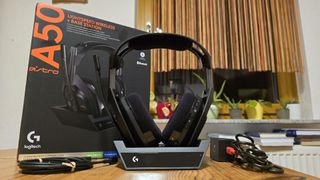
Simply put, there are no other headsets that really "do it all" without compromises. It could be said that the Astro A50 (Gen 5) is well and truly a "jack of all trades" type of headset (almost), whose every iteration enhances its performance in that category. I think to well and truly be a jack of all trades, Astro may have to explore redesigning the look of the headset while also adding a detachable mic for that "lifestyle" option for those who want something they can use in every aspect of daily life. But that's for another time.
For now, in gaming, specifically multi-platform gaming, the Astro A50 (Gen 5) absolutely has no equal.
You should buy the Astro A50 (Gen 5) if:
✅
You
are
a
multi-platform
gamer
who
values
versatility
and
convenience.
✅
You
want
a
high-quality
microphone
experience
for
comms
and
even
content
creation.
✅
You
want
a
solid
sound
experience
for
tactical
multiplayer
games.
You should not buy the Astro A50 (Gen 5) if:
❌
You
want
the
absolute
best
sound
stage
possible
for
cinematic
gaming.
❌
You
don't
really
need
connections
now
or
in
the
future
for
multiple
gaming
platforms.
While the soundscape could be better, and I'm not a huge fan of the "woolly" earcup fabric Astro uses by default, there's so much to love about this headset that it's just a sliver away from scoring 5/5 top marks. I remember when I reviewed earlier versions of the Astro A50 and was really unsure about the $300 price point, but that headset has lasted me five years through constant abuse, with very little battery degradation to speak of. I'm more than confident to say that the price is right now, even if there are a couple of compromises here and there — but I am a creature of comfort and a curator of convenience. If you are as well, then I'm confident you'll adore the Astro A50 (Gen 5).
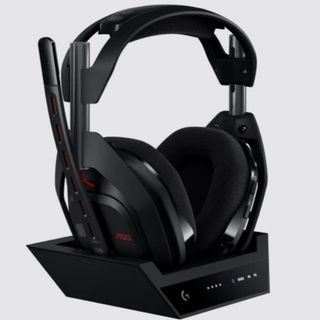
Astro A50 (Gen 5)
The Astro A50 (Gen 5) is a superb headset combo that offers a huge array of features, and doesn't compromise on quality. With solid audio reproduction, polished software, and decent comfort, the A50 remains one of the most convenient and versatile Xbox, PlayStation, and PC gaming headsets money can buy.
When you subscribe to the blog, we will send you an e-mail when there are new updates on the site so you wouldn't miss them.



Comments